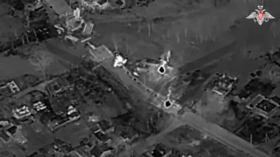Evidence lost in space: WATCH Russian cosmonauts whip out GoPros & forceps for zero-G investigation

One doesn’t simply poke inside a hole in a spacecraft during a spacewalk. The orbital operation required a lot of knife-work and struggle with a medical tool, but one piece of evidence was still lost beyond the stars.
On Tuesday, Sergey Prokopyev and Oleg Kononenko performed an extraordinary mission outside the Soyuz MS-09, currently docked at the International Space Station (ISS). The seven-hour spacewalk was part of Russia’s probe into how a hole came to be in the spacecraft. The breach was discovered in August after it started to leak air.
The leak itself thankfully was not life-threatening and was easily fixed with some epoxy sealant applied from the inside. It also poses no threat to the crew members, who will be using the Soyuz to return to Earth because the drilled Orbital Module will be jettisoned before the crew rides inside the Descent Module back into the atmosphere and experiences all the stress of a landing. But people in the space industry would really like to know who thought drilling a hole in a spaceship and trying to cover up the fact was a good idea.
With the culprit still unidentified, the two Russians went outside the ISS for a little investigation. Their task was to perform a sort of space surgery, cutting through the thermal insulation and anti-meteorite shield covering the Soyuz, and getting to its outer hull right at the spot where the hole is.
The operation was quite tricky for a number of reasons. First, the low-gravity environment really messes with a person’s ability to apply force. You have to brace yourself before doing anything or risk simply flying away with the first swing of a hammer – Newton’s third law doesn’t allow exceptions.
This may be a nuisance inside a spaceship, but outside it’s literally a question of life and death, so spacewalking requires a lot of tethers and points to attach them to. And in this particular mission, there seemed to be a shortage of the latter ones, requiring extra dexterity and mutual assistance form Prokopyev and Kononenko.
The thermal insulation is a multi-layer coating that has fabric, foil, and fibers. Getting through it required a lot of work with a knife and a cutter – and that had to be done with care, so as not to damage anything vital. The cosmonauts also had no way of knowing exactly where to cut and were using mission patches painted on the Soyuz as guides.
Some two hours after making the first incision, the hole was finally exposed. The crew’s task was to film the area on a GoPro camera for later study (it seems there were no drill marks on the outer hull, which was consistent with what was earlier learned from inside the spaceship) and collect samples of the epoxy used to seal the leak.
The current theory is that whoever damaged the module sealed it to cover up the blunder, but the sealant degraded in space and fell off, triggering the pressure drop. The new sealant theoretically may contain particles left by the original drilling, or biological samples from the person responsible. Since the module itself will be destroyed during the landing, it was the only chance to collect samples.
READ MORE: Stranded in space, Iron Man? Roscosmos is coming to rescue you!
The epoxy piece, which extruded from the outer hull, turned out to be large enough to be caught with Kocher forceps. But Kononenko quickly discovered that the tool is damn difficult to operate in a spacesuit with its bulky gloves. Even with both hands. Footage of the sampling operation showed how his first attempt to secure a piece of sealant failed and a chunk of the black stuff simply flitted away, lost forever. The second go, however, was quite successful.
Then Kononenko used some samplers to collect the remaining extra epoxy and swab the metal surrounding the hole. This went without a glitch.
The samples will be studied back on Earth, potentially leading to identifying whoever handled the drill that made the hole.
If you like this story, share it with a friend!















